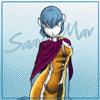
I've been spending a lot of time lately scanning very old examples of my artwork from covers of fanzines. I thought I'd share a few of the oldest, from the 1970's. A few days from now I'll upload some from the following decade.
A scene illustrating an early phase in my relationship with Saara Mar, when she was still learning about the simple pleasures of life on Earth. Back in those days she mainly wore the work-a-day silvery tunic that was as much a tool and extension of the hull of her starship as it was a garment.
The art is done entirely with ball point pen, even the liquid half-tones. It's a demanding but rewarding technique I haven't used in ages, because it also takes more time than it takes to paint the Cistine Chapel...
A scene illustrating an early phase in my relationship with Saara Mar, when she was still learning about the simple pleasures of life on Earth. Back in those days she mainly wore the work-a-day silvery tunic that was as much a tool and extension of the hull of her starship as it was a garment.
The art is done entirely with ball point pen, even the liquid half-tones. It's a demanding but rewarding technique I haven't used in ages, because it also takes more time than it takes to paint the Cistine Chapel...
Category All / All
Species Unspecified / Any
Size 700 x 961px
File Size 96 kB
It helps to have a ballpoint pen that doesn't "blob" -- I used to use Eagle fine points. Those got hard to find though, and I had to learn to make use of Papermate finepoints. Avoid Bic. Not only does it blob unpredictably, but the ink turns reddish over time.
Basically, you just move the pen very softly over the paper, so it doesn't leave a solid line. Then you do it again, and again, laying down ghostly lines side by side. It may take on too much of a linear texture. If it does, you can then do it again, runnng the lines the other way. Or you can fill in the space with small circular movements. Unfortunately, try your best, a certain amount of unwanted texture will probably be left. The texture of the paper will show. I was often able to counter it by drawing a bit heavier between the higher fibres. (Yeah, I know it sounds like I'm pulling your leg, but I'm not.) When all else failed, a very dilute solution of white ink or paint can be used to paint out the worst dark spots and blobs. But it take forever to do.
I only knew one other artist who used this technique -- George Barr. He used to write that he knew of no other artist who did. But we only met once and he was evidently in a hurry, so brushed me off before I could really tell him we had anything in common.
Basically, you just move the pen very softly over the paper, so it doesn't leave a solid line. Then you do it again, and again, laying down ghostly lines side by side. It may take on too much of a linear texture. If it does, you can then do it again, runnng the lines the other way. Or you can fill in the space with small circular movements. Unfortunately, try your best, a certain amount of unwanted texture will probably be left. The texture of the paper will show. I was often able to counter it by drawing a bit heavier between the higher fibres. (Yeah, I know it sounds like I'm pulling your leg, but I'm not.) When all else failed, a very dilute solution of white ink or paint can be used to paint out the worst dark spots and blobs. But it take forever to do.
I only knew one other artist who used this technique -- George Barr. He used to write that he knew of no other artist who did. But we only met once and he was evidently in a hurry, so brushed me off before I could really tell him we had anything in common.
Some were pretty small. The nicest one I had was about 20 inches long, and made of five strips of different coloured wood. It was very handsome. But it was high off the ground by modern standards. I've long wondered why that was, but I think it may be because the old skateboard was built to "lean" into turns, for doing slaloms. The modern board would bottom out if you leaned into a turn, and seems mainly made to jump. Thke old wheels left much to be desired. Orignally they were stamped metal, and plain awful. Then there were the odd pinkish wheels that seemed like ceramic or clay, but must have been some sort of plastic. They were superceded by much softer plastics. Huge boads like some of those you see today were a late development, so you could do rap headstands on them, and so on.
I had one until just a few years ago. But it was a pain taking out, and what was I going to do with it? Board back and forth on the sidewalk until felt silly enough to go in?
I'd love to know what forces Darwin plays on the sort of idiot who learns to do fancy tricks on a skateboard. A hundred must perish miserably, or cripple themselves, for every one who emerges able to board up the side of swimming pool, or down a staircase banister.
I had one until just a few years ago. But it was a pain taking out, and what was I going to do with it? Board back and forth on the sidewalk until felt silly enough to go in?
I'd love to know what forces Darwin plays on the sort of idiot who learns to do fancy tricks on a skateboard. A hundred must perish miserably, or cripple themselves, for every one who emerges able to board up the side of swimming pool, or down a staircase banister.
I believe I still have a wood-decked GrenTec board somewhere. Large wide wheels and a fairly high deck. I used to ride that one so fast that there'd be tracks in the sidewalk where the dist was sucked up by the wheels.
No stunts though, all I did was raw speed.
No stunts though, all I did was raw speed.

 FA+
FA+










Comments